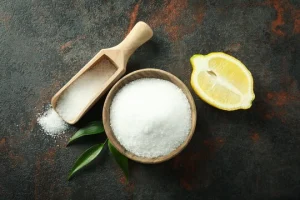When it comes to acids in food and beverages, citric acid and malic acid are two of the most commonly used. Both are naturally occurring organic acids and are often used as flavor enhancers, pH adjusters, and preservatives. However, they differ in terms of their taste, properties, and uses. In this blog, we will explore the differences between citric acid and malic acid and their applications in the food and beverage industry.

Citric Acid
Citric acid is a weak organic acid found in many fruits, including lemons, limes, oranges, and grapefruits. It is also produced commercially by the fermentation of sugar. Citric acid has a sour taste and is often used to add a tart or acidic flavor to food and beverages. It is widely used in soft drinks, energy drinks, and sports drinks, as well as in some candies, baked goods, and condiments.
In addition to its flavor-enhancing properties, citric acid has other uses in the food industry. It is often used as a pH regulator and preservative, helping to extend the shelf life of products. It can also be used as a chelating agent, helping to remove unwanted metals from food products.
Malic Acid
Malic acid is another naturally occurring organic acid found in many fruits, including apples, cherries, and grapes. It has a sour taste but is less acidic than citric acid. Malic acid is often used in sour candies and some fruit-flavored beverages. It is also used as a flavor enhancer in some processed foods, such as salad dressings and canned fruits.
Malic acid has some unique properties that make it useful in certain applications. For example, it can improve the texture of some foods, such as gelatin desserts and fruit fillings. It can also be used as a pH regulator and preservative, similar to citric acid.
Citric Acid vs Malic Acid
When comparing citric acid and malic acid, there are a few key differences to consider. First, citric acid is more acidic than malic acid, meaning it has a stronger sour taste. It is also more widely used in the food industry, as it is found in many fruits and is relatively easy to produce. Malic acid, on the other hand, has a milder taste and is used more selectively in certain applications.
Another key difference between the two acids is their chemical structure. Citric acid has three carboxylic acid groups, while malic acid has only two. This means that citric acid is more complex and can form stronger bonds with other molecules, making it useful as a chelating agent. Malic acid, however, has a simpler structure that can improve the texture of some foods.
Conclusion
In conclusion, both citric acid and malic acid are important organic acids used in the food industry. They have different properties and applications, with citric acid being more widely used and more acidic, and malic acid having a milder taste and some unique textural properties. Understanding the differences between these two acids can help food manufacturers choose the right acid for their product, depending on the desired flavor and other properties.
